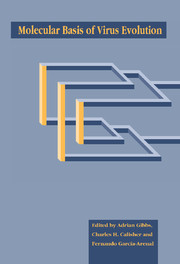Book contents
- Frontmatter
- Contents
- List of contributors
- Editors' preface
- Conference participants
- 1 Introduction and guide
- Part I The impact of viral diseases
- Part II Origins of viruses and their genes
- Part III Sources of virus variation
- Part IV Molecular interactions of viruses and their hosts
- Part V Viruses, hosts and populations
- 13 Quasi-species: the concept and the word
- 14 The co-evolutionary dynamics of viruses and their hosts
- 15 Population genetics of viruses: an introduction
- 16 Origin and evolution of prokaryotes
- 17 Molecular systematics and seed plant phylogeny: a summary of a parsimony analysis of rbcL sequence data
- Part VI Case studies of viral taxa; their systematics and evolution
- Part VII Techniques for viral systematics
- Index
14 - The co-evolutionary dynamics of viruses and their hosts
Published online by Cambridge University Press: 04 May 2010
- Frontmatter
- Contents
- List of contributors
- Editors' preface
- Conference participants
- 1 Introduction and guide
- Part I The impact of viral diseases
- Part II Origins of viruses and their genes
- Part III Sources of virus variation
- Part IV Molecular interactions of viruses and their hosts
- Part V Viruses, hosts and populations
- 13 Quasi-species: the concept and the word
- 14 The co-evolutionary dynamics of viruses and their hosts
- 15 Population genetics of viruses: an introduction
- 16 Origin and evolution of prokaryotes
- 17 Molecular systematics and seed plant phylogeny: a summary of a parsimony analysis of rbcL sequence data
- Part VI Case studies of viral taxa; their systematics and evolution
- Part VII Techniques for viral systematics
- Index
Summary
Introduction
This paper aims to give an overview of the dynamics and genetics of interactions between populations of viruses and their hosts. I emphasize that ‘successful’ parasites are those individuals who leave the most offspring, and that this does not necessarily mean evolving toward being harmless to the host (even though this may be the best for the viral population as a whole); many evolutionary trajectories are possible, depending on the constraints and trade-offs among viral virulence, transmissibility, and the costs of host resistance. These general ideas are illustrated by the particular cases of myxoma virus and Australian rabbits, and of HIV-1 and human hosts (where the role of ‘escape mutants’ of the virus, and of a possible ‘diversity threshold’ beyond which the immune system can no longer control the virus, are emphasized).
Viruses as ‘microparasites’
Viruses and other infectious agents that afflict humans and other animals are conventionally classified along taxonomic lines. In discussing the ecology or evolution of host/parasite associations, however, it is often more useful to make distinctions on the basis of the population biology of the interaction.
Microparasites (sensu Anderson & May, 1979) are those which have direct reproduction, usually at very high rates, within the host. They characteristically have small sizes and short generation times; the duration of infection is typically very short relative to the expected lifespan of the host, and hosts that recover from infection usually acquire immunity against re-infection for some time, often for life. The result is that most microparasitic infections are of a transient nature in individual hosts.
- Type
- Chapter
- Information
- Molecular Basis of Virus Evolution , pp. 192 - 212Publisher: Cambridge University PressPrint publication year: 1995
- 5
- Cited by



